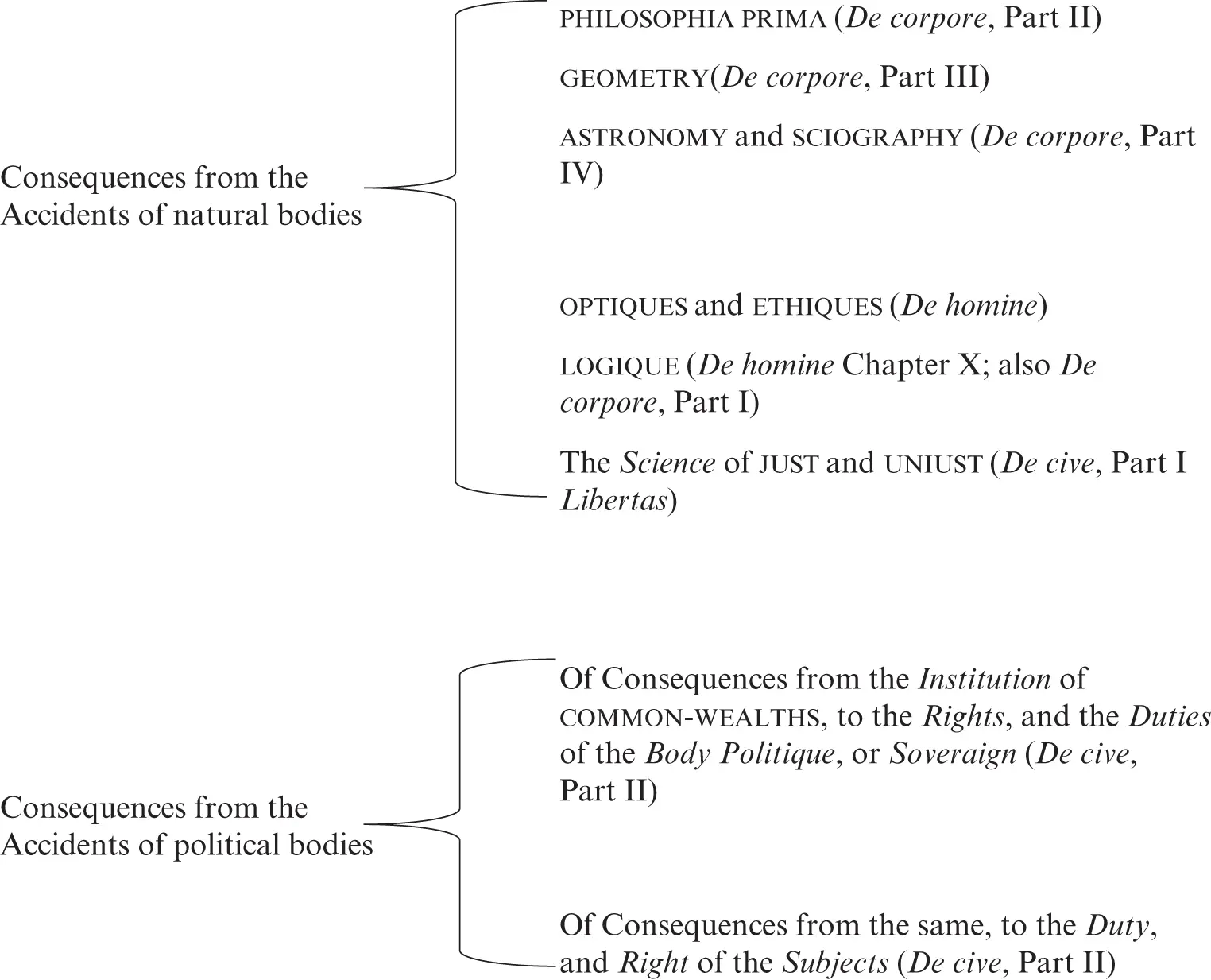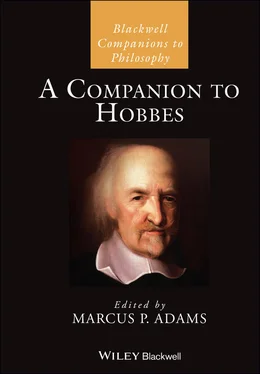A clear reason to treat Hobbes as a philosopher relates to his choice to name his trilogy the Elements of Philosophy , which he published in three sections: De corpore (1655), De homine (1658), and De cive (1642). Although the Leviathan (1651; 1668) has received significantly more attention, scholarly and otherwise, than these works, Hobbes devoted a great deal of time and attention to the Elements trilogy over the course of his writing career. We can infer, for example, that he was composing material related to the early chapters of De corpore in the 1630s and 1640s because there are extant notes on related topics from Payne and Cavendish. 8Indeed, Hobbes recounts for the reader of De cive that events beyond his control caused him to publish that work before publishing De corpore , his work concerning topics in method, first philosophy, geometry, and natural philosophy: “it happened that my country, some years before the civil war broke out, was already seething with questions of the right of Government and of the due obedience of citizens, forerunners of the approaching war” (Hobbes 1998, 13). Due to this civil unrest, Hobbes notes that he “put the rest aside and hurried on the completion” of De cive .
Another reason for examining Hobbes as a philosopher relates to the way in which he claims the parts of his thought depend upon one another. Although many philosophers today often specialize in one area or another of philosophy, Hobbes attempts, like others in his period and in the period preceding him, to offer a philosophical system with connecting points between metaphysics (first philosophy), epistemology, mathematics, natural philosophy, morality, and civil philosophy, among other areas. As has already been mentioned, this interconnectedness often led his critics to attempt to undermine central areas of his philosophy, such as his materialist metaphysics and natural philosophy, because they saw the consequences of his views in other areas as unacceptable. The remainder of this introductory chapter will consider how Hobbes presented his philosophy through his major works. Next it will discuss how A Companion to Hobbes has been organized in light of that presentation. Finally, the chapter will briefly outline strategies that try to make sense of how the parts of Hobbes’s philosophy depend upon one another.
1 The Presentation of Hobbes’s Major Writings
Broadly speaking, Hobbes’s major works follow roughly the same manner of presentation, from his early work Elements of Law (1640) 9through the two editions of Leviathan (1651 and 1668) and to the works in the trilogy Elements of Philosophy that were published between 1642 and 1658. There are many differences among these works, as some of the chapters in the present volume expose, but an overarching division in common in these writings is between what Hobbes calls natural bodies (“Bodies Naturall”) and political bodies (“Politique Bodies”) in the well-known Table provided in the English edition of Leviathan chapter 9(2012, 130; the Table is between 1651, 40–1). 10
The Table of Leviathan chapter 9traces the consequences from the accidents of natural bodies and political bodies. Following Hobbes’s display of the consequences following from the accidents of natural bodies, at the right-hand side of the Table the reader finds the disciplines that study them, such as first philosophy ( philosophia prima ), geometry, architecture, astrology, optics, ethics, and “The Science of just and uniust” (2012, 131). The terminating points of the consequences from accidents of political bodies are just the following:
1 Of Consequences from the Institution of common-wealths, to the Rights, and the Duties of the Body Politique, or Soveraign.
2 Of Consequences from the same, to the Duty, and Right of the Subjects. (2012, 130)
At first glance, this Table might appear like a schematic overview of the structure of Hobbes’s philosophy, i.e., it may look like Hobbes is showing the reader how the different parts of his philosophy relate to one another in terms of dependence relationships. However, there are difficulties with understanding the Table in this way. For example, since disciplines such as optics and geometry are both at the furthest right-hand side of the Table, the Table provides the reader without any explanation for why it is legitimate to use geometry in optics, as Hobbes does, for example, in De homine 2. Using geometry within optics, or in other investigations such as astronomy, music, or geography, would require one to cross from one terminating point of the Table into another, but the reason why such a move would be legitimate, as Hobbes’s practice implies, is not at all evident from the Table.
Similar difficulties arise in taking the Table to show the structural dependence relationships of civil philosophy to other parts of philosophy. Indeed, the “ Science of just and uniust” follows from “physiques” and not civil philosophy on the Table, showing that the line between natural bodies and political bodies may not be as precise as the Table seems to indicate. Given these difficulties in thinking of the Table as indicative of the structure of Hobbes’s philosophy, I suggest the Table is only an outline of subjects to be treated. In other words, the right-most side of the Table shows the order of subjects to be presented and not the dependence relationships among the parts of philosophy. 11
Even if Hobbes did not intend the Table to display how the parts of his philosophy fit together with one another, the Table does cohere with the overall manner of presentation in his major works. The two parts of Elements of Law (1640) fit this general structure, being divided into “Humane Nature” and “De Corpore Politico,” and the Leviathan ’s first two parts, Part I (“Of Man”) and Part II (“Of Common-wealth”), likewise mirror that same general structure. However, in the Elements of Philosophy trilogy, Hobbes covers much more ground than he does in Elements of Law or Leviathan . As a result, we can view the right-hand-side terminating points of the Table in Leviathan 9 as a guide to many of the additional subjects that one finds in Elements of Philosophy , and they appear in roughly the same order as they are presented on the Table. In Figure I.1, the parenthetical additions show where the right-hand-side terminating points of the Table from Leviathan 9 correspond to parts within the three sections of Elements of Philosophy , i.e., De corpore , De homine , and De cive .

Figure I.1 The order of presentation in Hobbes’s Philosophy: The Table of Leviathan 9 compared to the Elements of Philosophy trilogy.
This alignment of the right-hand side of the Table of Leviathan 9 with parts of the three sections of Elements of Philosophy leaves out some of the disciplines mentioned in the Table, such as “ Science of ENGINEERS” and “ARCHITECTURE” (2012, 131), but the present aim has been to show the broad overlap in the manner of presentation among Hobbes’s major works. The next section discusses the organization of this Companion .
2 The Organization of A Companion to Hobbes
The ordering of chapters in the present volume has been modeled after the manner in which Hobbes presents his philosophy in his major works, and so it has four sections devoted to Hobbes’s thought itself: Part I (First Philosophy, Mathematics, and Natural Philosophy), Part II (Human Nature and Morality), Part III (Civil Philosophy), and Part IV (Religion). The chapters in Part V (Controversies and Reception) consider the reception of Hobbes’s ideas by his contemporaries and by later figures. The diversity of the topics discussed by the chapters of Part V reflects the engagement of critics with the different parts of his philosophy, as well as the fact that many of his interlocutors saw those parts as deeply interconnected with one another.
Читать дальше













